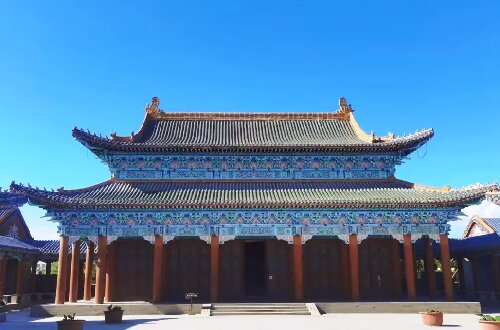Hami Hui Royal Palace

The Hami Hui Royal Palace was once a large-scale, magnificent and uniquely-styled palace building in Xinjiang, and was known as the "Little Forbidden City of the Western Regions." The current Hui Royal Palace scenic area is a reconstructed complex of ancient-style buildings. Here, visitors can experience the grandeur and exquisite craftsmanship of the former Hami Hui Royal Palace and learn about the history of Hami during the reign of the Hui Kings.
- Chinese name: 哈密回王府 Hā Mì Huí Wáng Fǔ
- Suggested time: 1-2 hours
- Ticket: 35 yuan per person
- Open hours: 09:30 - 20:00. Note that the opening hours may be adjusted during some special holidays. It's better to check in advance.
- The best time to visit: All year around
- Address: Opposite the Museum, Huancheng Road, Huicheng Township, Yizhou District, Hami City, Xinjiang Uygur Autonomous Region, China
- How to get there: Take Bus No. 10 and get off at the Museum Station, then walk about 300 meters to reach the destination.
- Surroundings: Hami Museum
Highlights of Hami Hui Royal Palace
The Prince's Platform
The Prince's Platform is the main and largest part of the scenic area. It was also the place where the Hui princes worked, conducted religious ceremonies, and lived in the past. The Prince's Platform is a large courtyard with a length and width of about 100 meters, featuring buildings such as the main administrative hall, the prince's living quarters and a mosque.
The Grand Hall of the Hui King
 The Grand Hall of the Hui King
The Grand Hall of the Hui KingThe Grand Hall of the Hui King is situated on higher ground. After ascending dozens of steps to reach the hall, visitors can overlook the buildings within the scenic area. When the Hui king initially had this hall constructed, it was modeled after the architecture of the Forbidden City, with Islamic elements incorporated. The solemn interior layout of the hall showcases the authority and status of the Hui king.
Courtyard House
The Siheyuan is located in the courtyard area on the left upon entering. It is a quadrangle approximately 30 meters in both length and width, once serving as a guest reception station for the royal palace. Its architectural style resembles that of a typical Chinese siheyuan.
Mosque
The main hall of the mosque features typical Han-style architecture, while the minaret exhibits Islamic domed and pointed arch design, creating a striking contrast. The exquisite interior decorations reflect Islamic aesthetics, making it a venue for religious activities of the Hui kings and palace personnel.
Educational Value
The architecture of the Hui Royal Palace integrates the architectural styles of the Central Plains Han people, Islamic, and local Uyghur, serving as a typical case for studying the integration of architectural technologies in China's border regions from the 17th to the 20th century. Its courtyard layout combines the arid climatic characteristics of the Western Regions, adopting designs such as high-platform buildings and patio ventilation, which reflects the scientific adaptation of architecture to the geographical environment and is well worth observing and learning from.
Activities to do at Hami Hui Royal Palace
Han-style Colored Painting Experience: Set up a workshop beside the Grand Hall of the Hui King to learn the painting of volute grass patterns and auspicious cloud patterns in traditional architectural color painting, and compare the differences between Chinese and Western decorative arts.
Architectural Conservation Practice: Organize practical activities of "ancient building disease investigation," where students can participate in detecting problems such as insect damage to wooden components and wall weathering, and learn conservation techniques.
Drop us a line and we'll connect you with the top China expert in no time!